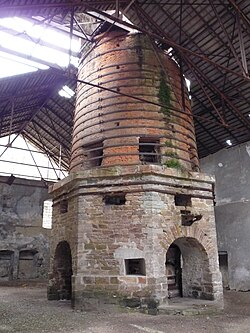Govăjdia Blast Furnace
| Govăjdia Blast Furnace | |
|---|---|
|
Native name Romanian: Furnalul din Govăjdia |
|

Octagonal stone base, conical brick body wrapped in iron girdles, dotted with blast holes.
|
|
| Location | Govăjdia village, Ghelari Commune, Hunedoara County, Transylvania region |
| Coordinates | 45°44′27″N 22°47′28″E / 45.740708°N 22.791063°ECoordinates: 45°44′27″N 22°47′28″E / 45.740708°N 22.791063°E |
| Built | 1806 - 1813 |
| Rebuilt | 1851 (modified) |
| Type | monument of industrial architecture |
| Designated | 2000 |
| Part of | Historic monuments in Hunedoara County |
| Reference no. | LMI Code: HD-II-m-A-03322 |
| Country |
|
The Govăjdia Blast Furnace is a disused blast furnace in Govăjdia village, Ghelari Commune, Hunedoara County, in the Transylvania region of Romania.
An earlier blast furnace had been set up at Topliţa in 1781, but the quantity of raw materials it prepared for workshops involved in cast iron refining proved inadequate. Thus, the Thesaurariat at Sibiu, which represented the Imperial Austrian authorities, coordinated mining activities in Transylvania and had an office based in the Hunyad Castle, decided in 1802 to build a second furnace in the Hunedoara area. The site chosen was at the confluence of two rivers close to a group of forge works and iron mines. Construction began in 1806, and although finished in 1810, production only began in April 1813, once the necessary annexes had been built. A tablet placed on the front of the furnace read: Augusto Imperante Francisco Extructum 1810 ("Built 1810 during the reign of the venerable Francis").
The furnace's first period of use was fairly short at seven and a half months, as the crucible had become quite worn and enough cast iron had been generated to last the nearby workshops three years. In all, 1380.3 tons of cast iron were produced. Periods of repair, use and abandonment followed over the ensuing century. In 1837, a fire caused structural damage to the furnace, and an investment of 40,529 forints was approved. Its volume was expanded to 26.45 m3, the water wheel was repaired and the bellows compressor was improved. On August 25, 1840, an air preheater began operating. In 1841, a narrow gauge railway for transporting ore to the furnace's upper opening was installed. Little wagons would load the ore downward into the furnace; this mechanism replaced the inclined planes used earlier. The railway was 246.8 m long and made of cast iron from Govăjdia, and was the first such of its kind in Transylvania, extended to Hunedoara in 1900 (see Transylvanian mining railway). The cooling systems, the loading mechanism and the continuous production cycle were quite advanced for contemporary Europe. Its most intense period of production took place between 1871 and 1889, and metal prepared there as well as at the Reşiţa works was used for raw material in the building of the Eiffel Tower. Activity lessened after 1896 due to the new Hunedoara Steel Works. The final repairs were made in 1914–1916, and the last batch of steel came out in 1918. The furnace closed down permanently in 1924.
...
Wikipedia

